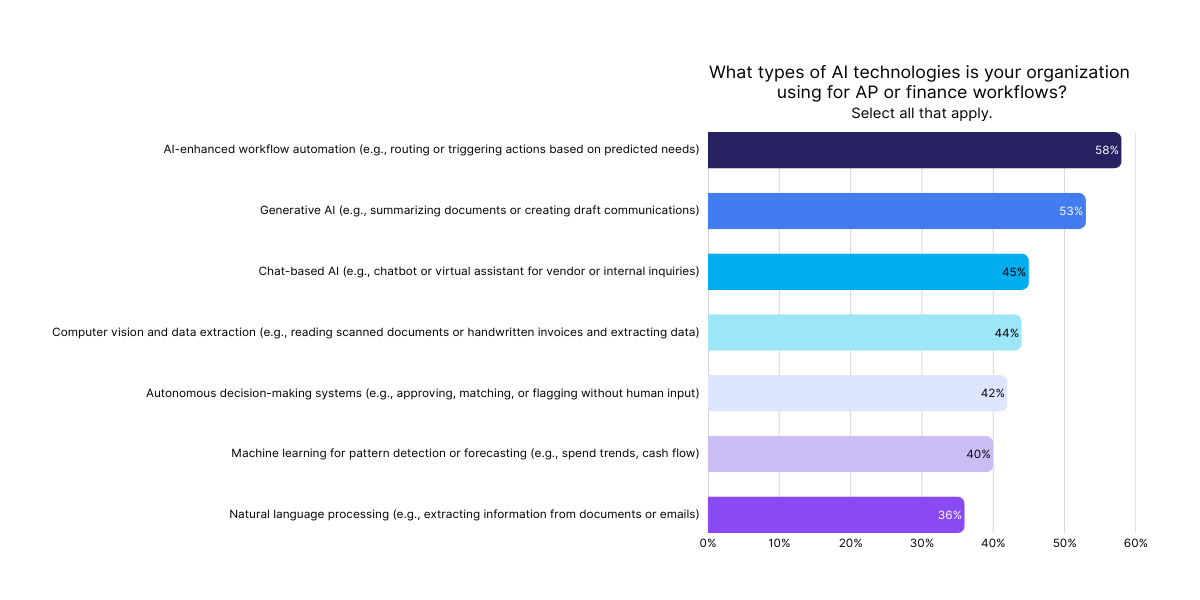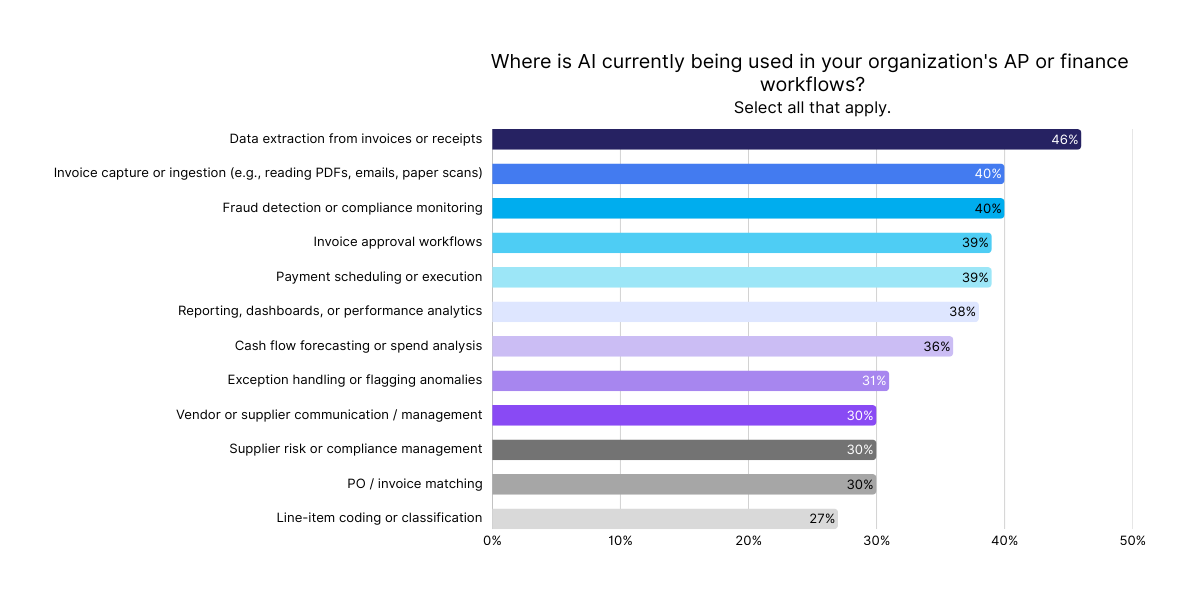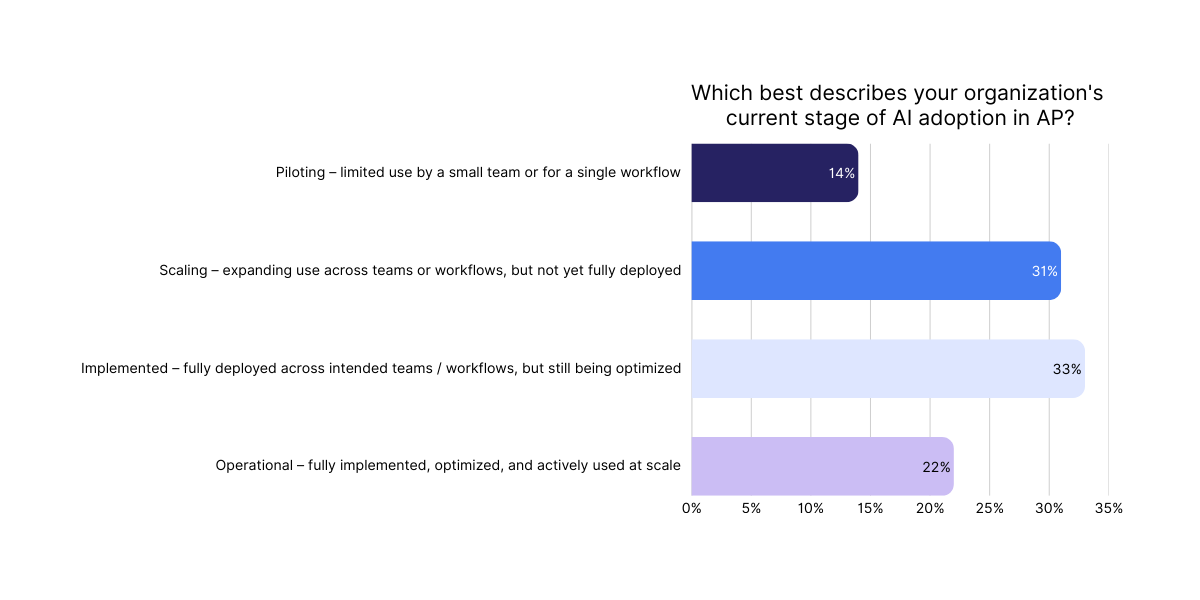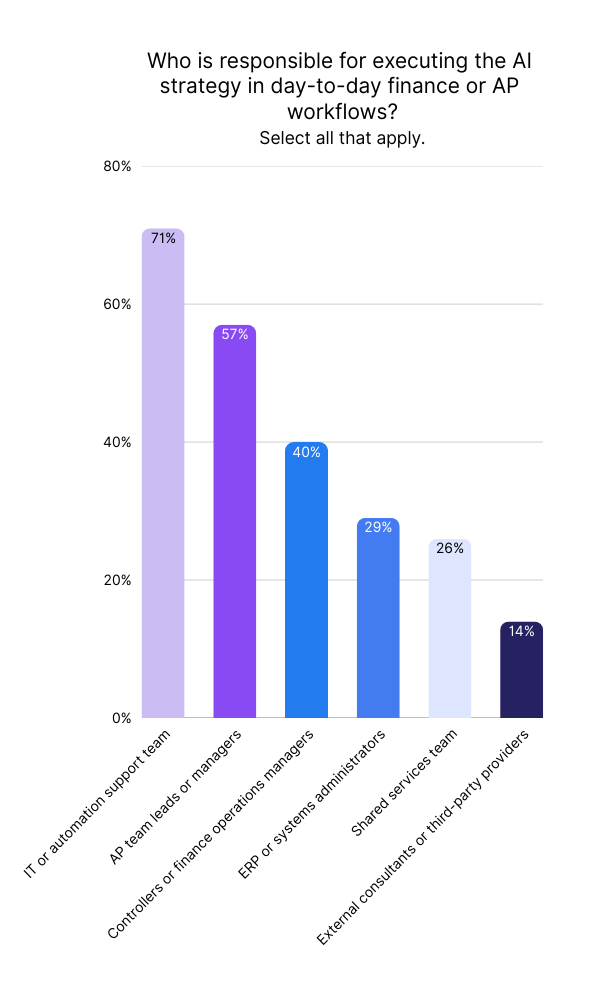72% of AP or finance teams now use some form of AI. See where adoption is strongest, how leaders are scaling, and what it means for CFOs and Controllers.
Artificial intelligence (AI) in finance is no longer a future concept — it’s already embedded in the day-to-day workflows of many accounts payable (AP) and finance teams.
According to the Vic.ai 2025 AI Momentum Report, a new benchmarking survey of nearly 800 finance professionals, 72% of organizations now use some form of AI in their finance operations. What was once experimental is now operational.
For CFOs and Controllers, this marks a pivotal shift: AI is no longer happening at the margins but across finance, in diverse forms and stages of maturity.
From early experiments to everyday workflows
Finance has traditionally lagged behind other functions in adopting new technology. Enterprise resource planning (ERP) systems, for example, took decades to reach mainstream use. However, AI is moving much faster.
Today, AI-enhanced workflow automation (58%) and generative AI (53%) lead, while teams are also experimenting with chat-based AI (45%), computer vision for data extraction (44%), machine learning (40%), and autonomous systems (42%). Even natural language processing, considered less essential for AP, is used by more than a third of organizations (36%).
The result: AI is no longer just running pilots or proofs of concept. It’s improving speed, accuracy, and efficiency across finance workflows — from invoice capture to fraud detection, approvals, payments, and reporting.
For finance leaders: Benchmark your own roadmap against this spread of technologies (see chart below). If your organization is only experimenting with one or two tools, recognize that peers are already layering multiple forms of AI into end-to-end processes.

What AI is solving in finance
The 2025 AI Momentum Report shows that AI is no longer confined to niche pilots; it’s now touching nearly every step of the AP and finance lifecycle. Organizations are applying AI where it can drive immediate, measurable impact: reducing manual workload, improving accuracy, and strengthening controls.
- Data extraction (46%) remains the most common entry point, automating one of the most time-consuming and error-prone tasks in finance.
- Invoice capture and ingestion (40%) extends that benefit further, allowing teams to automatically process PDFs, emails, and even paper scans with minimal human intervention.
- Fraud detection and compliance monitoring (40%) is another critical use case, showing how AI isn’t just about speed but also about risk reduction.
From there, adoption spreads across core finance workflows:
- Invoice approvals (39%) and payment scheduling/execution (39%) highlight how AI is accelerating decision-making and cash movement.
- Reporting and analytics (38%) and cash flow forecasting (36%) reflect AI’s role in providing strategic insights that go beyond transactional efficiency.
- Exception handling (31%), supplier communication and risk management (30%), and PO/invoice matching (30%) show how AI is chipping away at the persistent bottlenecks and headaches that slow down teams.
- Even line-item coding/classification (27%), often a tedious back-office function, is seeing meaningful automation.
The impact: AI is not just reducing friction at the “front end” of finance but also safeguarding and streamlining processes all the way through approvals, payments, and reporting. This dual effect — efficiency plus control — explains why adoption has accelerated so quickly.
For finance leaders: Use the data below to benchmark your own processes. If your team is still bogged down by manual data entry, exception handling, or supplier follow-ups, these are areas where peers are already deploying AI and seeing measurable results. Non-users consistently cite high-volume, error-prone tasks as the clearest opportunities for AI adoption, which means starting here not only aligns with industry trends but also addresses the pain points your team feels most acutely.

Adoption timelines: Rapid growth, but maturity varies
Another clear signal that AI has gone mainstream in finance is just how recently most teams began their journey. Seventy-two percent of organizations adopted AI within the past two years, reflecting the speed at which adoption has accelerated.
- 37% have been using AI for 1–2 years, long enough to move beyond initial experimentation and start building institutional knowledge.
- 35% adopted within the last 6–12 months, underscoring how fresh and fast-moving this trend is.
But the real story is not just when adoption began, it’s where organizations sit today on the maturity curve:
- 14% are still piloting, with limited use in small teams or single workflows.
- 31% are scaling, expanding AI across multiple teams or workflows but not yet fully rolled out.
- 33% are implemented, with full deployment underway and ongoing optimization.
- 22% are fully operational, running AI at scale and actively reaping measurable benefits.
This split highlights an important reality: while more than half (55%) of finance teams say they’ve reached implementation or operational maturity, nearly half (45%) are still in pilot or scaling phases. In other words, mainstream adoption doesn’t mean universal maturity.
The impact on teams: Organizations further along the curve are already embedding AI into everyday workflows, which compounds efficiency gains and builds a stronger internal knowledge base. Those still piloting risk falling behind — not just in productivity, but in building the organizational learning curve that makes scaling smoother over time.
For finance leaders: Ask yourself: Are we still piloting while peers are scaling? If so, the gap isn’t just about speed; it’s about readiness. Teams with AI fully operational are already aligning strategy, KPIs, and talent around new ways of working. Moving too slowly risks creating an adoption lag that will be harder (and more expensive) to close later.


Scaling with strategy and KPIs
Early experiments with AI in finance often lacked clear direction, but that’s no longer the case. According to the Vic.ai 2025 AI Momentum Report, 82% of organizations using AI now have a defined strategy in place, signaling a major shift from opportunistic pilots to structured adoption. Only 9% say they do not have a strategy, and another 9% are unsure.
Who sets strategy?
- IT and data teams (60%) lead most often, supported by CIOs/CTOs (48%).
- Finance leaders are heavily involved: 41% point to CFOs, 36% to heads of finance/AP.
- A smaller but growing group (21%) have a dedicated AI/automation lead.
Who executes?
- IT or automation teams (71%) provide support, but AP managers (57%) and Controllers/finance ops leaders (40%) increasingly own daily execution.
- ERP admins (29%) and shared services (26%) round out support.
Setting KPIs
Just as importantly, organizations are tracking impact. KPI measurement is now widespread, with finance teams most often monitoring:
- Processing time (a leading indicator of efficiency)
- Accuracy (critical for trust and compliance)
- Cost per invoice (the most direct measure of financial ROI)
Many organizations also point to secondary benefits such as faster approvals, lower error rates, improved compliance visibility, and higher employee satisfaction as staff shift away from repetitive work toward more analytical or strategic contributions.
For finance leaders: AI in finance is no longer ad hoc — it’s structured, measured, and tied to leadership accountability. If your team lacks a defined strategy or clear KPIs, you risk not only lagging behind peers, but also missing the organizational learning and ROI visibility that come with disciplined execution.
Tools finance teams rely on
When asked about tool selection, the survey found teams rely on general-purpose platforms and finance-specific solutions. Many teams lean on familiar enterprise tools, such as generative AI assistants and ERP extensions, to add AI capabilities quickly. At the same time, a growing segment is investing in specialized platforms purpose-built for AP and finance, signaling a shift toward deeper automation and domain expertise.
On one side, general AI platforms (like generative assistants and productivity copilots) are widely used to support document drafting, analysis, and ad-hoc tasks. ERP and finance system vendors are also embedding AI features directly into their platforms, making AI a natural extension of existing workflows.
On the other side, AP-specific platforms are gaining traction for organizations that want automation designed from the ground up for finance. Solutions such as Vic.ai represent this new category: AI-native tools built to eliminate manual invoice processing, optimize approvals, and deliver real-time financial intelligence.
For finance leaders: Consider whether you’re layering general-purpose AI on top of existing systems or adopting AI-native solutions built specifically for finance. Both approaches are common, but purpose-built tools often deliver deeper automation and faster ROI.
Why broader AI adoption matters for finance leaders
With most organizations already using AI in finance, standing still is no longer a neutral choice. Delaying adoption doesn’t just minimize risk — it means falling behind peers who are capturing efficiency gains, building institutional knowledge, and reshaping their operating models today.
We’ve seen this cycle before. Cloud computing began as a curiosity, became a competitive differentiator, and is now a baseline expectation. AI in finance is moving along the same trajectory, only faster.
For CFOs and Controllers, the path forward comes down to three critical questions:
- Where can AI deliver the fastest impact in my workflows?
- How do I scale responsibly while building trust in outcomes?
- How do I align systems, teams, and processes to maximize both efficiency and accuracy?
The data is clear: AI adoption in finance has gone mainstream. What was once a forward-looking conversation is now an operational reality. The leaders who act now aren’t experimenting — they’re setting the foundation for the next generation of finance.
The good news? The opportunities for efficiency, accuracy, and strategic insight are within reach, if you’re ready to move. Access the full Vic.ai 2025 AI Momentum Report to explore these findings in detail, as well as adoption trends, practical use cases, and the investments shaping the next era of finance.











.svg)
